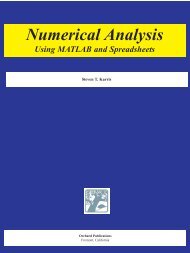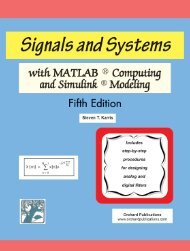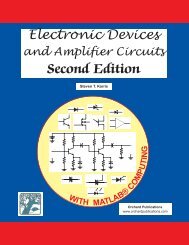endof-
Signals & Systems Front Cover FOURTH.qxp - Orchard Publications
Signals & Systems Front Cover FOURTH.qxp - Orchard Publications
Create successful ePaper yourself
Turn your PDF publications into a flip-book with our unique Google optimized e-Paper software.
Partial Fraction ExpansionSolution:Using (3.6), we obtainThe residues areandF 1 ( s)Therefore, we express (3.9) asF 1 ( s)3s + 2= -------------------------s 2 + 3s + 23s + 2 3s + 2= ------------------------- = -------------------------------- =s 2 + 3s + 2 ( s + 1) ( s + 2)F 1 ( s)= -------------------------3s + 2= ---------------–1s 2 + 3s + 2 ( s + 1)+ 4( --------------- s + 2)and from Table 2.2, Chapter 2, Page 2−22, we find thatr 1r 2---------------( s + 1)+ ( --------------- s + 2)3s + 2r 1 = lim ( s + 1)Fs( ) = --------------- = –1s → – 1( s + 2)s = – 13s + 2r 2 = lim ( s + 2)Fs( ) = --------------- = 4s → – 2( s + 1)s = – 2(3.8)(3.9)(3.10)(3.11)(3.12)Therefore,F 1 ( s)e – at u 0 () t⇔ 1s---------- + a= ---------------–1 4( s + 1)+ ( --------------- ⇔ (– e – t + 4e – 2t )u 0 () t = fs + 2)1 () t(3.13)(3.14)The residues and poles of a rational function of polynomials such as (3.8), can be found easilyusing the MATLAB residue(a,b) function. For this example, we use the scriptNs = [3, 2]; Ds = [1, 3, 2]; [r, p, k] = residue(Ns, Ds)and MATLAB returns the valuesr =p =k =4-1-2-1[]Signals and Systems with MATLAB ® Computing and Simulink ® Modeling, Fourth EditionCopyright © Orchard Publications3−3







